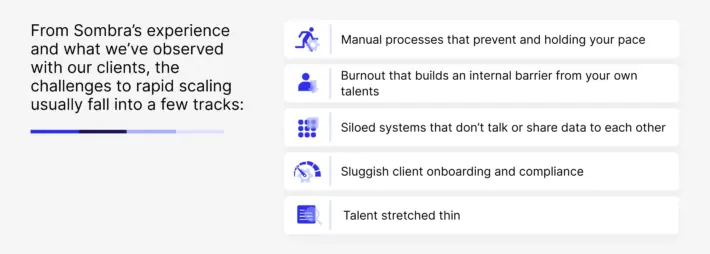When you think about scaling, the first images that usually come to mind are the visible ones — a bigger office, a new country on the map, more clients, more people. For decades, this has been the default definition of growth: expanding one’s physical and human footprint to mirror financial progress.
But in financial services — especially in wealth management and investment firms — this definition is dangerously incomplete. Growth on paper often hides operational fragility underneath. Behind the brand-new branch and the impressive client portfolio, you’ll still find a heavy reliance on manual work, repetitive reporting cycles, and entire departments chained to Excel.
For many wealth management firms, this wasn’t a choice but a survival strategy.

Until recently, this model was effective. When the workload increased, you simply hired more advisors. When compliance requirements became stricter, you hired more analysts. Adding personnel was the solution to every operational bottleneck. It worked — until it didn’t.
Today, that equation no longer holds. Economic turbulence, rising client expectations, and cost pressures have made relying solely on hiring for growth unsustainable. Firms cannot simply hire their way out of bottlenecks when market cycles become volatile, or profit margins shrink. While client portfolios continue to expand, payroll cannot keep pace.
So, the real question becomes: how do you scale operations without increasing headcount?
That’s what this series of articles explores. How firms can scale smarter — not by multiplying staff, but by optimizing how work actually happens. In this first part, we’ll start where every digital transformation in asset management begins: at the root cause of why financial institutions grow in numbers, but not in efficiency.
The Root Cause: Cracks in Wealth Management Operations
The most common scaling mistake is addressing symptoms instead of the root causes. When operations slow down, many managers respond similarly: they hire additional staff to check reports, fill gaps, or manually synchronize data between systems. For a short time, it helps. But with every new hire, complexity grows — and so does the cost of maintaining it.
At a certain point, the model collapses under its own weight.
What makes this pattern so persistent is that it feels rational. You trust people, not systems. Hiring is faster and simpler than redesigning workflows. And when risk is measured in basis points, trusting automation feels reckless. But what was once a conservative choice has now become a liability.

These issues don’t appear overnight — they accumulate silently, like technical debt. Each spreadsheet, each duplicated process; each manual check becomes part of a fragile infrastructure that resists change.
So, what should the smart manager do? Arm themselves with tech and process reengineering.
Here’s one example of Sombra’s practice. A wealth management firm seeking to scale effectively initiated a modernization of its CRM and implemented workflow automation. They integrated Plaid for instant access to bank data and used AI to prioritize tasks. Suddenly, that small team could operate like a much larger one — with greater accuracy, 24/7 speed, faster client onboarding, and stronger compliance. They were able to scale operations without increasing headcount.
To break through, financial firms just need to start with the root-causes.

In short, you don’t need more bodies to grow — you need better systems and the right tech partners. Here are three key strategies for building a solid foundation for scaling operations in wealth management.
1. Wealth Management Operations and Processes
Most financial institutions aren’t failing because the market’s shrinking; they’re failing because the internal rhythm can’t keep up with growth. When systems don’t align, even simple workflows become high-risk trades: one manual update, one missed field, and you lose hours, client trust, and control.
The Bottleneck
In typical wealth management firms, core systems operate in silos: legal and oversight rules in one system, accounting in another, analytics elsewhere, and CRM in a fourth. These departments all share clients, but not data. Between the systems sit people: copying info, verifying records, sending spreadsheets. In the acquisition of Credit Suisse by UBS, integrating over 1.3 million clients and thousands of applications revealed the significant amount of manual reconciliation that still exists in modern operations.
The irony? Many firms already have the right data but just can’t use it. That forces analysts, advisors and operations staff into “manual mode” at scale. When growth accelerates, these micro-gaps widen. Errors rise, lead times stretch, cost pressure builds.
Tech Fix — Build Agile Operations: The first step is to digital transformation in asset management is to redesign and automate core workflows so your processes can handle 5x or 10x of the volume without breaking. Key approaches include:
- Custom Workflow Automation: Implement tailored platforms (CRM systems, fund administration software, portfolio management tools) configured to your unique processes. Automate routine tasks such as entering client data, generating documents, and processing transactions.
- Integration Layers: Unify your fragmented systems with API-driven integration. For example, connect your onboarding, KYC, compliance, and client communication systems so data flows seamlessly. An integration layer ensures that when a client updates information, all associated systems, from compliance to reporting, remain synchronized in real time. For example, when UBS combined systems after Credit Suisse, they decommissioned legacy apps, migrated clients, and freed up contractors.
- Process Intelligence & RPA: Use process mining and robotic process automation to analyze how work is getting done and eliminate bottlenecks. These tools can highlight, for instance, that analysts spend 40% of their day copying data between systems – insight that lets you re-engineer that task or automate it entirely.
By streamlining in this way, wealth management operations become both efficient and scalable.

These savings free up resources that can be reinvested in client-facing innovation. In one example, a wealth management firm we worked with reduced its investor onboarding time by 60% after deploying a unified client data hub with automated bank-linking and KYC checks.
2. Focus on Advisor Experience in Wealth Management
Every firm says, “People are our greatest asset.” Yet internally, many of those people spend half their day performing tasks that software could do. That’s the paradox: teams of senior advisors and analysts — managing substantial portfolios — still operate via email chains, manual spreadsheets, scattered dashboards.
Thus, operational strength relies on people running the system. When their tools are fragmented, even the best talent spends time compensating for bad design: chasing documents, correcting errors, verifying disconnected systems.

When internal friction is high, growth falters. Talent leaves. Mistakes rise. Turnover surges just when you need stability.
Tech Fix — Elevate the Digital Employee Experience: To scale effectively, companies must make the work easier and more engaging for the people behind the scenes. A positive DEX is essential for sustainable growth and digital transformation in asset management. Here’s how leading firms improve DEX:
- User-Friendly, Automated Tools: Provide employees with modern platforms that prioritize usability and automate the drudge work. For example, integrate an intuitive workflow tool that auto-populates data and handles routine approvals, so staff spend less time on tedious copy-paste tasks.
- Role-Based Dashboards & Collaboration: Give each role a single pane of glass showing the key info they need, whether it’s a compliance officer tracking approvals or an account manager monitoring client onboarding status. No more digging through email threads or multiple spreadsheets — a well-designed dashboard surfaces priorities and flags bottlenecks instantly. Collaboration also improves when everyone works off the same real-time data.
- AI-Powered Task Management: Introduce smart task management that uses AI to prioritize work and identify blockers. For instance, an AI assistant can triage incoming requests or highlight which client cases need immediate attention, reducing the cognitive load on your team. It can even suggest the next best action or gather relevant documents automatically, saving employees time and effort.
The result of these investments is an engaged, enabled operations team that can handle growth without burnout. Automating repetitive tasks and providing teams with better tools not only enhances productivity but also demonstrates that you value their time and well-being.
This translates to higher retention and a culture where employees focus on strategic, fulfilling work instead of firefighting daily tasks. Happy, empowered teams will naturally deliver better service to clients and support expansion. As one tech leader put it, automation helps IT staff “work smarter, not harder” — reducing errors and boosting morale in the process.
In short, a strong digital employee experience means your small team can perform like a much larger one because they have the right support, not because they’re working themselves into the ground.
Embrace Technological Advancements — Intelligently
Finally, the most important piece — technology itself. Today, every financial firm understands the importance of utilizing technologies such as artificial intelligence, data analytics, and real-time platforms. The buzz around AI, machine learning, RPA, and more is impossible to ignore. But look around: the AI assistant at the Chicago Sun-Times recommends fake books, New York’s chatbot tells business owners to break the law, and Amazon’s recruitment tool once suggested hiring only men.

Source: IBM survey
Sombra’s approach is to start where it’s needed and invest wisely. Too often, companies either freeze up, unsure which emerging tech will actually deliver value, or they dive in headfirst, chasing shiny new tools that don’t yield ROI — or worse, disrupt operations. The result is a lot of analysis of paralysis in mid-sized firms. They know they need better data and AI-driven insights to compete, but they fear wasting budget on the wrong solutions or implementing technology that staff won’t fully adopt.
Tech Fix — Strategic, Measured Innovation: You don’t have to go “full AI” on day one. The most successful firms take an incremental, value-focused approach to new technology. Here’s how to proceed:
- Targeted AI & Analytics Pilots: Start small and measure everything. For instance, JPMorgan Chase launched an internal “LLM Suite” for ~200,000 employees, beginning within its wealth-management division. The output: productivity gains, but more importantly, an internal adoption “flywheel” among teams. Another firm used an AI assistant for estate-planning summaries, reducing what took hours into minutes. These examples show: pick narrow, high-impact use-cases, demonstrate value, then scale. As Deloitte’s AI leaders note, choosing the right use cases and measuring progress are critical to generating real value at scale.
- Legacy Modernization via Microservices: Gradually modernize your legacy systems by breaking them into modular components and API-accessible microservices. This way, you can upgrade pieces of your architecture without a risky full rip-and-replace. For instance, wrap up an old portfolio management system with new API layers so it can feed data to modern analytical tools. Over time, replace heavy legacy modules with faster, cloud-based services that integrate smoothly.
- Data Engineering & Governance: Invest in robust data pipelines and governance, so decisions are based on clean, real-time data. Scaling efficiently means everyone from the front office to compliance is working off a “single source of truth.” A well-designed data infrastructure (with proper data quality checks, master data management, and security controls) ensures that your fancy new analytics or AI tools actually have reliable fuel. Good data is the bedrock of any tech-enabled transformation.
By advancing on these fronts, firms can leap forward digitally without stumbling. The goal is to continuously adopt new capabilities – AI, better data, cloud agility — but in a way that aligns with your business strategy and risk appetite.
Remember, technology is a means to an end, not an end. It’s about selecting investments that drive efficiency, insight, and customer value. As Gartner and other experts often advise, look for quick wins (like adding AI features to an existing CRM or automating a single workflow) to demonstrate impact, then iterate.
Over time, these incremental improvements compound into a formidable, modernized operation. You’ll be able to scale services, adapt to change, and compete on digital footing — all without proportionally scaling your payroll.
You Don’t Need More People — You Need a Scalable Foundation
Growth in financial services is about building smart systems and processes that multiply the productivity of your existing teams. Imagine your advisory team as a high-performance engine. Increasing the number of advisors when the engine is not properly tuned only leads to higher fuel consumption and added complexity.
To improve performance, first tune the engine: integrate the fuel lines, align the pistons (workflows), upgrade the driver’s interface (DEX), and then install the turbocharger (AI/automation). That’s what scaling looks like in today’s wealth management and investment firms.
Crucially, you don’t have to embark on this journey alone. Having the right tech partner can accelerate your transformation and help avoid pitfalls.
At Sombra, we bring deep industry expertise and proven IT consulting capabilities to financial services firms that are ready to scale — not with spreadsheets and stress, but with precision and tech-enabled confidence. We’ve helped wealth managers and asset management companies reinvent their operations for agility and resilience.
With a scalable foundation in place, your firm can turn ambitious growth goals into operational reality — while keeping your team and clients happy. Let’s talk about building your scalable operations strategy for sustainable, tech-powered growth.






